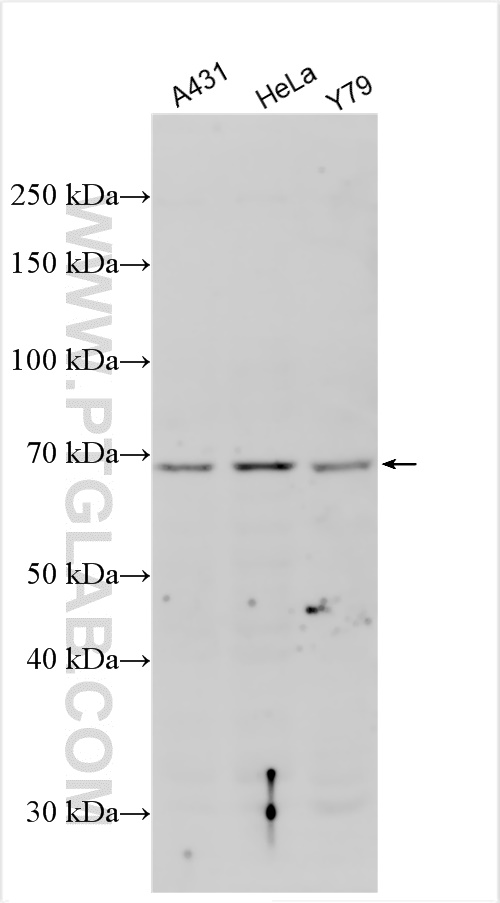验证数据展示
经过测试的应用
| Positive WB detected in | A431 cells, HeLa cells, Y79 cells |
推荐稀释比
| 应用 | 推荐稀释比 |
|---|---|
| Western Blot (WB) | WB : 1:500-1:2000 |
| It is recommended that this reagent should be titrated in each testing system to obtain optimal results. | |
| Sample-dependent, Check data in validation data gallery. | |
产品信息
16850-1-AP targets Cytokeratin 3 in WB, ELISA applications and shows reactivity with human samples.
| 经测试应用 | WB, ELISA Application Description |
| 经测试反应性 | human |
| 免疫原 | Peptide 种属同源性预测 |
| 宿主/亚型 | Rabbit / IgG |
| 抗体类别 | Polyclonal |
| 产品类型 | Antibody |
| 全称 | keratin 3 |
| 别名 | Cytokeratin 3-specific, KRT3, keratin 3, Cytokeratin-3, CK-3 |
| 计算分子量 | 64 kDa |
| 观测分子量 | 68 kDa |
| GenBank蛋白编号 | NM_057088 |
| 基因名称 | Cytokeratin 3 |
| Gene ID (NCBI) | 3850 |
| RRID | AB_3669258 |
| 偶联类型 | Unconjugated |
| 形式 | Liquid |
| 纯化方式 | Antigen affinity purification |
| UNIPROT ID | P12035 |
| 储存缓冲液 | PBS with 0.02% sodium azide and 50% glycerol , pH 7.3 |
| 储存条件 | Store at -20°C. Stable for one year after shipment. Aliquoting is unnecessary for -20oC storage. |
背景介绍
Keratins are a large family of proteins that form the intermediate filament cytoskeleton of epithelial cells, which are classified into two major sequence types. Type I keratins are a group of acidic intermediate filament proteins, including K9-K23, and the hair keratins Ha1-Ha8. Type II keratins are the basic or neutral courterparts to the acidic type I keratins, including K1-K8, and the hair keratins, Hb1-Hb6. As a member of the type II cytokeratin subfamily, KRT3 is expressed together with KRT12 during 'corneal-type' differentiation.
实验方案
| Product Specific Protocols | |
|---|---|
| WB protocol for Cytokeratin 3 antibody 16850-1-AP | Download protocol |
| Standard Protocols | |
|---|---|
| Click here to view our Standard Protocols |
